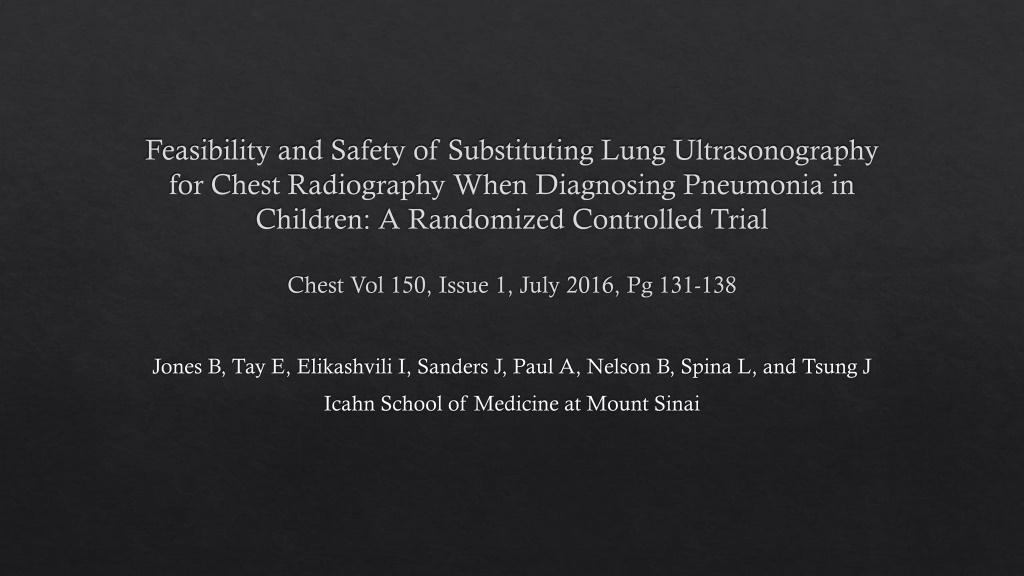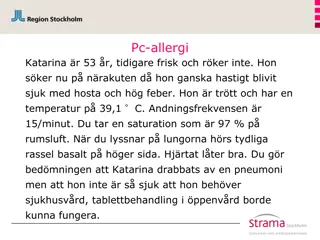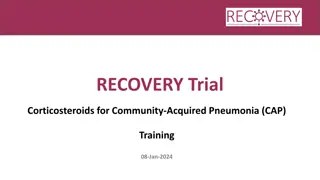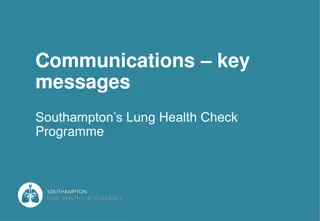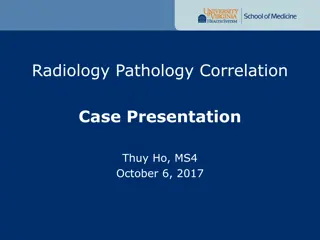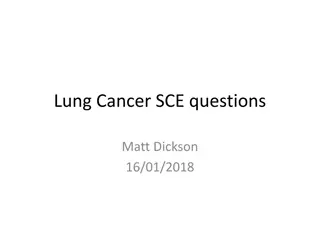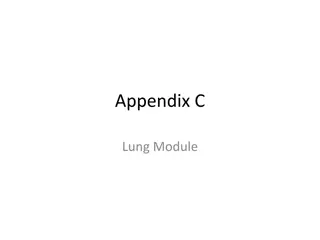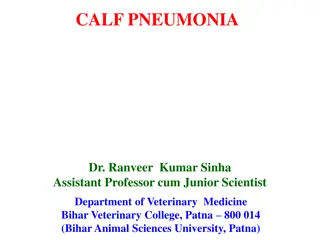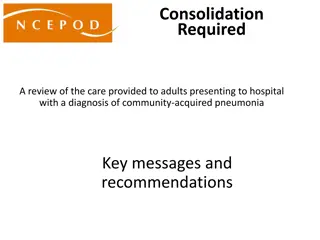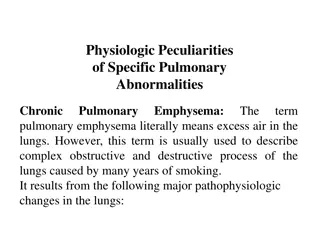Utility of Lung Ultrasonography in Pediatric Pneumonia Diagnosis
Pneumonia, a leading cause of pediatric mortality globally, presents diagnostic challenges as history and physical exams may not reliably differentiate viral lung infections from bacterial pneumonia. This study explores the feasibility and safety of substituting lung ultrasonography (LUS) for chest radiography (CXR) in diagnosing pediatric pneumonia. Results show LUS, being portable, cost-effective, and radiation-free, can be an effective imaging tool for diagnosing pneumonia in children, potentially overcoming limitations in accessing traditional imaging methods. The study involved training pediatric physicians in LUS techniques and establishing a scanning protocol to define pneumonia based on sonographic findings of lung consolidation with air bronchograms. Overall, the research highlights the potential of LUS as a valuable alternative to CXR for diagnosing pneumonia in pediatric populations.
Uploaded on Oct 04, 2024 | 0 Views
Download Presentation

Please find below an Image/Link to download the presentation.
The content on the website is provided AS IS for your information and personal use only. It may not be sold, licensed, or shared on other websites without obtaining consent from the author. Download presentation by click this link. If you encounter any issues during the download, it is possible that the publisher has removed the file from their server.
E N D
Presentation Transcript
Feasibility and Safety of Substituting Lung Ultrasonography for Chest Radiography When Diagnosing Pneumonia in Children: A Randomized Controlled Trial Chest Vol 150, Issue 1, July 2016, Pg 131-138 Jones B, Tay E, Elikashvili I, Sanders J, Paul A, Nelson B, Spina L, and Tsung J Icahn School of Medicine at Mount Sinai
Hypothesis Can lung ultrasonography (LUS) be safely and feasibly used as a substitute for chest x-ray (CXR) when diagnosing pneumonia in the pediatric population?
Background Pneumonia is the leading cause of pediatric death worldwide History and physical are not always reliable to differentiate viral lung infection vs. bacterial pneumonia CXR is the current test of choice, but WHO estimated ~75% of the population don t have access to imaging LUS has proven effective for diagnosing pneumonia in past studies LUS is portable, cheaper, and has no radiation exposure
Materials and Methods Where: Pediatric emergency department in an urban academic center When: Summer 2012-2013, patients enrolled 24/7 by available study physicians Who: Patients ranging from birth to 21 years of age presenting with clinical suspicion of pneumonia (combination of fever, cough, tachypnea, abnormal auscultation) requiring CXR Data collected with standardized data collection form Excluded hemodynamically unstable patients or those with prior CXR
Sonographer training 15 pediatric emergency department physicians and fellows Varying levels of previous ultrasound experience Attended 1 hour LUS training session prior to start of study 30 minute lecture on recognition of disease 30 minute hands-on scanning session of normal models
Technique Six zone scanning protocol 10-5MHz linear array transducer https://img.grepmed.com/uploads/450/assessment-diagnosis-pneumonia-technique-aliem-original.png
Defining pneumonia on ultrasound Sonographic findings of lung consolidation with air bronchograms Sub-centimeter pneumonia is defined as focal lung consolidation with air bronchograms less than 1cm in diameter and undetectable on CXR B-lines, confluent B-lines, and small subpleural consolidations without air bronchograms were considered viral in etiology
Lung Ultrasonographic Images Figure 1
Assignments Investigational vs. control arm Random assignment with permuted blocks of variable lengths of 4-20 subjects, stratified by sonologist experience Defined novice as those who had performed 25 LUS examinations Defined experienced sonologists as those who had performed >25 LUS examinations No blinding of assignments due to nature of study
Intervention Investigational arm: Underwent LUS Option to perform CXR if clinical uncertainty or request from referring physician, admitting service, or guardian LUS interpretations documented prior to CXR Radiologists were blinded to LUS results Control arm: Underwent CXR followed by LUS No blinding to CXR results so that the information could be used to guide treatment
Quality control Imaging performed and interpreted by study sonologists Single investigator sonologist blinded to clinical exam findings also separately interpreted images Investigator sonologists reviewed images and video to classify errors by study sonologists Also calculated intra-observer agreement between study sonologists and the single investigator sonologist Interim analysis of 60 subjects to assess for excess adverse events (missed pneumonia)
Outcome measures Primary outcome was rate of CXR reduction Secondary outcomes included: Subsequent unscheduled health-care visits Missed pneumonia- pneumonia as diagnosed by a health-care provider during a repeat ED or other health care visit with radiographic or clinical evidence of pneumonia and initiation of antibiotics Adverse events Rates of antibiotic use ED length of stay Hospital admission rates
Statistical Analysis Calculated sample size needed for >80% power to detect absolute reduction of CXR use by 15% or more in investigational arm Needed 60 subjects minimum to each arm Primary analysis based on intention to treat Secondary analysis based on ED length of stay (EDLOS) for those who did/did not get CXR in investigational group Outcomes compared with Pearson chi-squared test Alpha set at 0.05, 95% CI, all comparisons two tailed
Primary outcome 38.8% reduction in CXR in investigational arm NNT of 2.5 Novice sonologists showed 30% reduction, while experienced sonologists showed 60.6% reduction Accounting for requested CXRs, maximal reduction of 67%, and NNT of 1.5
Secondary Outcomes Intention to treat analysis showed nonsignificant 26.5 minute reduction in LOS Secondary analysis showed significant reduction of median EDLOS in LUS only group Otherwise no significant differences
Measuring cost Payer perspective Average CXR in US at time of study was ~$370 Average POCUS at this institution was ~$140 (similar to national estimates) Multiplied difference by the number of times CXR was not used in the investigational arm $9,200 cost reduction in investigational arm Did not include factors such as hospital costs or indirect costs
Discussion LUS did result in reduced CXR use No missed cases of pneumonia with LUS alone Cost savings Reduced radiation exposure Increased efficiency Nonsignificant 10.6% increase in antibiotic use due to better detection of sub-centimeter nodules
Limitations Single center study in urban academic center No reference for 38.8% of intervention arm due to lack of CXR No blinding to CXR results in control arm, needed to guide treatment CXR use in control arm was 100% by design A no intervention arm would have been useful to compare against purely clinical decision-making, but unethical Physicians in intervention arm could not be blinded to LUS results, resulting in quicker treatment Possibly insufficient power for secondary outcomes Imbalance in arms due to incomplete blocks by sonologists
Next steps Determining which scenarios are ideal for LUS substitution Incorporating LUS into WHO algorithm Evaluate impact of LUS on antibiotic use
Impact on Practice Seemingly safe and comparable to CXR Multiple benefits As with all ultrasonography, operator dependent Also requires ultrasound access
